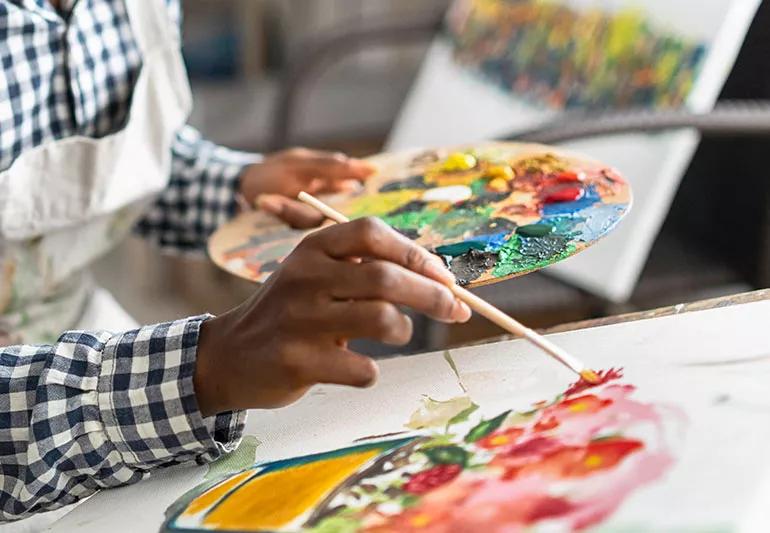It’s nothing like your average arts and crafts session

When you hear the words “art therapy,” what comes to mind? Coloring in an adult coloring book? Taking a paint-and-sip class? Arranging fresh-cut flowers, or making a collage with all of your old concert tickets? While art is at the center of these activities, and you feel calmer and more at ease as you’re tapping into your creativity, what you’re doing isn’t art therapy in the technical sense.
Advertisement
Cleveland Clinic is a non-profit academic medical center. Advertising on our site helps support our mission. We do not endorse non-Cleveland Clinic products or services. Policy
Art therapy manager, Tammy Shella, PhD, ATR-BC, explains what art therapy is, who can benefit from it and what an art therapist actually does.
Shella describes art therapy as a clinical and evidence-based mental health practice that utilizes art-based interventions. These interventions are conducted by credentialed art therapists to support physiological, psychological and emotional growth, and healing for patients.
“The main idea of art therapy is to utilize art as another form of expression, especially for things that might be difficult to express verbally. The art therapist and patient may discuss the art: What is included, the “story” it tells, and/or the emotions it represents which can help the patient gain personal insight or understanding,” says Shella.
She adds that art therapy is a relatively young field, with roots in the 1940s. Shella says professional training programs started popping up in the 1960s and the American Art Therapy Association was later established in 1969.
Art therapists in hospitals — often known as medical art therapists — focus on helping patients cope with hospitalization. Shella adds that this might include managing anxiety, stress or pain, processing new diagnoses or treatment plans, coming to terms with long hospital stays or provide memory-making opportunities to help patients and their families navigate end of life issues.
Advertisement
“Patients are referred for art therapy via a doctor’s order. Once a referral is received, an art therapist does a chart review and then meets with the patient to assess their needs, set goals and introduce or suggest the right media to achieve these goals,” explains Shella.
As for education and certifications, art therapists are required to have a Master of Arts in Art Therapy from an accredited college or university. They must also complete clinical and internship placements and are required to have 1000 hours of supervised work post-graduation to be eligible for registration and board certification through the Art Therapy Credentials Board.
The art form that a patient might engage with all comes down to what they are going through, says Shella.
Art therapy can include a wide variety of media. “Patients may draw, paint, utilize fiber arts, sculpt, make collages and do much more,” says Shella. “Art therapists tend to offer numerous options to give patients a sense of choice. This is very important, especially during hospitalization since some patients may feel like they don’t have much of a say in their treatment,” she says.
Sometimes, the art media used may also depend on the goals of the session. For example, if the goal is anxiety reduction, the therapist might suggest and art form that is free-flowing like watercolor paint or inks. If the goal is to release tension or anger, the therapist might suggest something more kinesthetic, like working with clay since it can be pounded and molded or creating torn paper art to help release energy.
One good example of this is how art therapy helps those who have post-traumatic stress disorder (PTSD). Shella says patients who have experienced trauma may have PTSD, which is believed to be processed in the non-verbal areas of the brain. Individuals who are living with PTSD often experience it through their senses: Sights, sounds, smells or touch. Shella stresses that while talking about the trauma helps, being able to express it in a non-verbal way can be more effective in helping to relieve it.
While Shella works in a hospital, she says that art therapists can be found in a variety of settings. “Art therapy is offered in schools, nursing homes, rape crisis centers, domestic violence centers, hospice facilities and even in private practice.”
She says a variety of populations can benefit from art therapy, including:
If there’s one thing that Shella wants to clear up, it’s the belief that art therapy is like a craft night with friends.
She explains.
“Many people think that art therapy is a form of entertainment or just ‘a fun job.’ While working with art materials can be enjoyable, art therapy sessions still serve a very therapeutic purpose. Helping people deal with trauma, end-of-life issues, extended hospitalization, a new, unexpected diagnosis or chronic mental health issues is emotionally taxing work regardless of the tools used during the therapeutic process.”
Advertisement
She also says that one of the keys to this practice is working with a credentialed art therapist to meet goals. So it’s not adult coloring books and other trendy creative activities that people gravitate towards. “Coloring can be relaxing and enjoyable for many. However, it is not art therapy. Believing that it is would be like saying you had physical therapy because you went for a walk.”
Another misconception is that art therapy is just for children. It’s not. Shella says that people of all ages can benefit from it. Art therapy can also be instrumental in helping people:
Some might be under the impression that only artistic people will benefit from this creative form of therapy. But a patient doesn’t have to be a great sketch artist, sculptor or painter. They just need to have an open mind and a willingness to participate.
“Art therapy is primarily about the process of creating. It does not matter if the art is aesthetically pleasing (although it often is). It’s more about the many benefits that the creative process can provide. Art-making engages the non-verbal parts of our brain and can help people express emotions that are too difficult to verbalize. Sometimes talking about the art creates distance between the person and their feelings, so they may feel safer to discuss what is in the art.”
Advertisement
Advertisement
Learn more about our editorial process.
Advertisement

Most recommended precautions center around minimizing bruising or swelling

Even one drink can have an impact on your cognitive function leading to slurred speech, blurred vision and impaired memory

Understand who may (and may not) benefit

Lorem ipsum dolor sit amet. Et odio Quis vel ipsam omnis eum alias deleniti et placeat impedit non voluptas galisum hic autem enim et cupiditate aliquid. Est beatae quidem non facilis autem ut commodi nisi aut tempore rerum et dolores voluptatem cum enim optio id sapiente quasi. Ad laboriosam officiis 33 cupiditate sequi ea voluptatum consectetur qui necessitatibus voluptate et quasi doloremque et facere explicabo quo explicabo officia

Seeking help through therapy can be an important step in improving your quality of life when you have UC

Type 2 diabetes isn’t inevitable with these dietary changes

Applying a hot or cold compress can help with pain